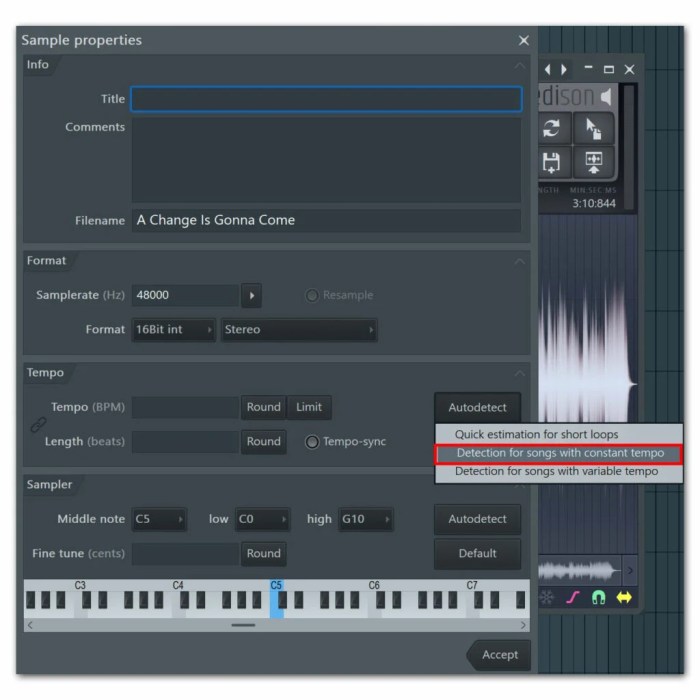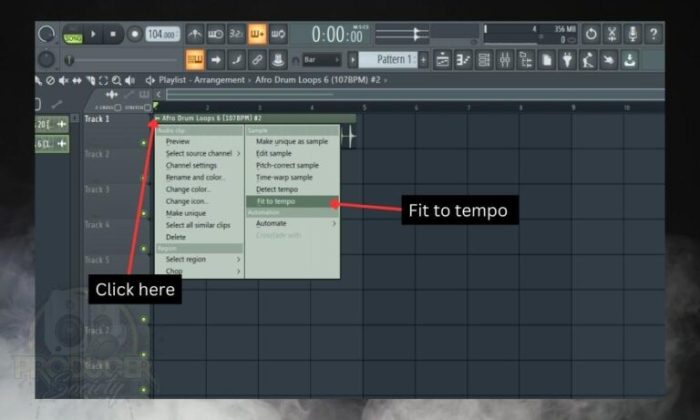Stretch a Sample in FL Studio opens a world of creative possibilities for music producers. This guide delves into the art of manipulating audio samples, from basic stretching to advanced techniques like warping and granular synthesis. We’ll explore how to achieve diverse sonic textures, enhance existing sounds, and even create entirely new instruments within FL Studio’s powerful environment.
This comprehensive tutorial walks you through the various methods for stretching samples in FL Studio, covering fundamental concepts, practical applications, and troubleshooting common issues. Learn how to master pitch shifting, time-stretching, and other techniques to transform a simple sample into a complex, genre-bending sound. We’ll cover everything from basic adjustments to advanced warping methods, giving you the tools to take your music production to the next level.
Introduction to Stretching Samples in FL Studio
Sample stretching in FL Studio is a powerful technique that allows producers to manipulate the duration and pitch of audio samples, creating a wide range of sonic effects. This flexibility is crucial for adapting pre-recorded sounds to fit a specific musical context or to create unique textures. It’s a cornerstone of many music production styles, enabling artists to transform existing sounds into something new and exciting.The core concept revolves around altering the playback rate of a sample without changing its inherent timbre or quality.
This is achieved through time-stretching algorithms, which essentially adjust the spacing between audio data points to lengthen or shorten the sample’s duration. Sophisticated algorithms consider factors like waveform shape and spectral characteristics to maintain the sample’s original quality as closely as possible.
Time-Stretching Algorithms
Time-stretching algorithms are fundamental to sample manipulation. These algorithms work by analyzing the audio signal and calculating the necessary adjustments to maintain the original timbre and quality while altering the duration. They can be broadly categorized as:
- Phase-Vocoder: This is a popular approach that manipulates the phase information of the audio signal. It’s often preferred for its ability to handle complex waveforms and maintain good quality even with significant time stretching. The phase-vocoder method works by dividing the audio into short frames and analyzing their spectral characteristics. Adjustments are made to these frames to achieve the desired time stretching.
This technique effectively compensates for phase changes during stretching, preserving the overall sound quality.
- Resampling: This method involves converting the audio signal into a different sampling rate. While simpler than phase-vocoder, it can sometimes introduce artifacts, particularly when dealing with large time stretches. The key here is to choose an appropriate resampling algorithm to minimize any distortion.
- Other advanced techniques: Various other sophisticated methods exist, each designed to address specific needs. Some incorporate machine learning approaches, while others focus on preserving specific aspects of the audio. This ongoing development in time-stretching algorithms continually improves the fidelity and control offered in software like FL Studio.
Common Use Cases
Sample stretching is versatile and has numerous applications across diverse music genres:
- Creating unique textures and atmospheres: By stretching samples, producers can generate evolving and complex soundscapes, adding depth and atmosphere to a track. For example, stretching a short, repetitive drum sample can create a hypnotic rhythmic pattern, or stretching a vocal sample can create a shimmering chorus effect.
- Adapting samples to different tempos: Changing the tempo of a song often requires altering the length of samples to maintain the correct rhythmic relationships. Stretching enables precise adaptation of pre-recorded material to different tempos without losing their rhythmic character.
- Creating melodic variations: Stretching and pitching samples can produce novel melodic variations. By gradually changing the pitch and duration of a sample, you can generate a series of interesting and unexpected musical ideas.
Key Terminology
| Term | Definition |
|---|---|
| Sample | A short segment of audio data, often used as a building block in music production. |
| Time Stretching | Altering the duration of an audio sample without changing its pitch. |
| Pitch Shifting | Altering the frequency of an audio sample, changing its perceived pitch. |
| Time-Stretching Algorithm | A method used to modify the duration of an audio signal, preserving the original timbre as much as possible. |
| Phase-Vocoder | A popular time-stretching algorithm that manipulates the phase information of the audio signal. |
Methods for Stretching Samples in FL Studio
Sample stretching, a crucial aspect of sound design in FL Studio, allows you to manipulate the duration and pitch of audio samples. This process empowers musicians to create unique soundscapes and dynamic textures within their productions. Mastering different stretching methods is key to achieving a desired sonic effect. Knowing how to effectively manipulate samples opens a vast realm of creative possibilities.
FL Studio offers a variety of tools for stretching samples, each with its own strengths and weaknesses. Understanding these tools will empower you to choose the best method for achieving the specific sonic outcome you envision. From subtle pitch adjustments to significant time alterations, the process can be easily adapted and controlled.
Pitch Shifting
Pitch shifting is a method that alters the perceived pitch of a sample without changing its duration. This is useful for creating variations in the tone of a sound, for instance, moving a sample from a high register to a low register. It’s frequently used to create vocal effects or to transpose sounds to different keys.
In FL Studio, pitch shifting is typically achieved through the use of the built-in “Pitch” parameter within the Sample Editor. Adjusting this parameter alters the frequency of the audio, effectively changing its perceived pitch. A positive value raises the pitch, while a negative value lowers it. The “quantization” option helps align the shifted pitch with specific musical intervals.
Learning to stretch a sample in FL Studio is a crucial skill for any producer. It’s all about manipulating the audio to create unique sounds and textures. Understanding the “ones dollarilkmoneys why lie,” as discussed in this insightful piece the ones dollarilkmoneys why lie , can help you appreciate the artistry and potential behind sample manipulation, which is directly relevant to stretching a sample to fit a particular beat.
Ultimately, mastering sample stretching in FL Studio opens up a world of sonic possibilities.
Time Stretching
Time stretching, unlike pitch shifting, modifies the duration of a sample while maintaining its original pitch. This is crucial for creating rhythmic variations and effects, such as slowing down or speeding up a sample without changing its key. Time stretching is often used in creating unique sound textures and manipulating the tempo of a track.
Learning to stretch a sample in FL Studio can be surprisingly rewarding, especially when you consider how it can transform a simple loop. For example, hearing Ethel Cain join Florence and the Machine on a new version of “Morning Elvis” ( ethel cain joins florence and the machine on new version of morning elvis listen ) really highlights the power of manipulation and creative reimagining of sounds.
This same concept translates directly to stretching a sample, allowing you to create unique textures and rhythms within your own productions.
FL Studio’s Sample Editor provides the “Time” parameter for adjusting the duration of a sample. You can either stretch or compress the sample by entering a numerical value in this parameter. Increasing the value stretches the sample, making it longer; decreasing the value compresses it, making it shorter. The effect is noticeable and can produce distinct rhythmic variations in the music.
Comparison of Methods
While both pitch shifting and time stretching are valuable tools, they cater to different needs. Pitch shifting is ideal for altering the tonal characteristics of a sample without affecting its rhythmic structure. Time stretching, on the other hand, focuses on altering the rhythmic aspects of a sample while preserving its original pitch. Understanding these differences allows for a more informed decision about the appropriate stretching technique.
Available Stretching Tools
| Tool | Functionality |
|---|---|
| Pitch Parameter | Alters the perceived pitch of a sample without changing its duration. |
| Time Parameter | Adjusts the duration of a sample without changing its original pitch. |
These tools offer precise control over the stretching process, allowing you to experiment with various parameters to achieve the desired outcome.
Advanced Stretching Techniques
Taking sample stretching beyond basic time-stretching, advanced techniques like warping and granular synthesis open up a world of creative possibilities. These methods allow for precise manipulation of sonic elements, enabling the creation of unique textures and evolving soundscapes. Mastering these techniques empowers you to shape your samples in ways previously unimaginable, adding depth and complexity to your productions.Warping, a powerful tool, provides greater control over the sample’s shape and timbre.
Granular synthesis, on the other hand, dissects the sample into tiny particles, allowing for unparalleled sonic manipulation. Both techniques are crucial for creating intricate, dynamic sounds.
Warping Algorithms and Their Sonic Results
Warping algorithms offer diverse ways to reshape audio, each yielding a distinct sonic character. Understanding the differences between algorithms is essential for achieving the desired effect.
| Warping Algorithm | Sonic Characteristics | Typical Applications |
|---|---|---|
| Linear Warp | Maintains a consistent pitch shift across the entire sample. | Simple pitch shifts without significant harmonic distortion. |
| Time-Scale Warp | Adjusts the sample’s duration while maintaining a perceived pitch. | Creating time-based effects, stretching out phrases or altering tempos. |
| Spectral Warp | Focuses on the spectral content of the sample, adjusting frequencies in a sophisticated manner. | Precise pitch control, avoiding unwanted harmonic distortions, particularly useful for complex sounds with numerous overtones. |
| Free Warp | Allows for very precise, manual manipulation of the sample’s waveform, providing the most granular control over its shape. | Complex sonic design, intricate sound transformations, creating unique sonic textures and alterations in timbre. |
Granular Synthesis for Sonic Exploration
Granular synthesis breaks down a sample into tiny grains, each of which can be individually manipulated. This approach provides an unparalleled level of sonic detail and control.
Learning to stretch a sample in FL Studio can be a game-changer for your productions. It’s a crucial skill for manipulating sounds and textures, and it’s a bit like how Andy Serkis, in a recent interview, explained the complexity of the Star Wars villain Snoke – deeply wounded, but still powerful. Andy Serkis says Star Wars villain Snoke is deeply wounded reveals a similar depth of character you can achieve by manipulating your samples in FL Studio – adding layers and nuance to your sound design.
This method is key to creating a richer sonic landscape in your music productions.
- Sample Granulation: This process involves dividing the sample into discrete “grains” which are then individually manipulated in terms of playback speed, pitch, and position. This allows for highly detailed and nuanced control over the sound, enabling effects like granular delays, rhythmic patterns, and intricate sound design.
- Grain Size and Density: The size of the grains and their density in the audio signal affect the sound’s texture. Smaller grains produce a more detailed and complex sound, while larger grains create a smoother, more consistent sound. The density of grains affects the overall intensity of the sound.
- Grain Shifting and Filtering: Granular synthesis allows for shifting the individual grains in time and manipulating their frequencies through filtering. This can create a multitude of effects, such as vibrato, pitch shifting, and complex sound transformations. These manipulations enable creative control over the sample’s evolution and create unique sonic textures.
Manipulating Playback Speed and Pitch
Precise control over playback speed and pitch is crucial for creating nuanced sounds. Advanced techniques like warping and granular synthesis offer the tools for achieving this without losing audio quality.
“Careful adjustment of parameters within these techniques allows for seamless alterations in pitch and tempo, preserving the integrity of the original sample’s harmonic content.”
The key to maintaining quality lies in the algorithm’s ability to handle the manipulation. Sophisticated algorithms, particularly in warping, often interpolate data points between sample points to avoid introducing artifacts or glitches in the audio output.
Advanced Applications
The application of advanced stretching techniques goes beyond simple time stretching.
- Creating evolving soundscapes: By manipulating the pitch and time of different sections of a sample, you can create dynamic sounds that evolve and change over time. This technique is used extensively in electronic music for creating sounds that have a sense of movement and change.
- Generating unique sonic textures: Granular synthesis and warping can transform a simple sample into a rich tapestry of sonic textures. These techniques allow for the creation of unique sounds, adding layers of detail and complexity.
- Modifying instrument sounds: Advanced stretching techniques can be used to modify the sounds of instruments, altering their timbre and creating new sonic possibilities. This allows for creative alterations of sounds, such as creating new instrument sounds from existing samples.
Practical Applications of Stretching Samples
Sample stretching isn’t just a technical skill; it’s a powerful tool for crafting diverse sounds and textures in your music. By manipulating the length and pitch of audio clips, you can create evolving soundscapes, alter rhythms, and even design entirely new instruments. This unlocks a vast sonic palette, extending far beyond the original sample’s potential.The key to mastering sample stretching lies in understanding its versatility.
Stretching isn’t merely about lengthening or shortening a sound; it’s about sculpting its sonic character. This flexibility allows for creative sound design, enabling producers to transform familiar samples into something truly unique.
Creating Evolving Soundscapes
Dynamic soundscapes often rely on subtly shifting sounds over time. Sample stretching allows you to achieve this effect with ease. By gradually stretching and compressing samples, you can create a sense of growth, decay, or atmosphere. Imagine a plucked string sample, stretched to become progressively higher in pitch, mimicking a rising crescendo. This method can also create a sense of movement, as if the sound is evolving and expanding.
Altering Rhythm and Groove
Stretching can significantly impact the rhythmic feel of a sample. This is incredibly useful for creating intricate grooves and polyrhythms. For instance, you could stretch a snare drum sample to alter its rhythmic complexity. This is especially helpful when working with complex drum loops or percussion patterns.
Designing Unique Instruments
Beyond altering existing sounds, sample stretching is vital in creating new instruments. Take a simple synth pad sample and stretch it over a wider range of frequencies. Combining this with effects like reverb and delay can produce a unique sonic texture that mimics a custom instrument.
Enhancing Existing Sounds
Sample stretching is a powerful tool for enhancing existing sounds. A simple pluck sample can be stretched to add subtle vibrato, making it more expressive. This technique can be used to subtly change the timbre of any sample, transforming it into something fresh and engaging.
Creating New Sounds
The power of sample stretching lies in its ability to create completely new sounds. By stretching a simple vocal sample and layering it with other stretched samples, you can craft a unique and textured vocal instrument. This process involves experimentation, but the potential rewards are enormous.
Integrating into Production Workflows
Sample stretching can be seamlessly integrated into your production workflow. Use it in conjunction with other effects like EQ, compression, and reverb to achieve a wide array of sounds. For instance, a stretched and processed sample could be used to create the intro for a track, or serve as a unique background texture.
Examples: Creating a Specific Sound Effect
| Sound Effect | Sample | Stretching Technique | Other Effects |
|---|---|---|---|
| Evolving Drone | Simple sine wave | Gradually stretch and compress over several bars. | Reverb, delay, subtle pitch modulation. |
| Unique Percussion | Snare drum hit | Stretch to create rhythmic variations, change the tempo and alter the attack | EQ to sculpt tone, compression to control dynamics. |
| Synthetic Lead | Simple synth pad | Stretch across a wider frequency range, apply a pitch shifter, add a chorus effect. | Reverb, delay, chorus, slight vibrato. |
Troubleshooting Common Issues
Sample stretching, while powerful, can sometimes lead to unwanted results. Understanding the common pitfalls and their solutions is crucial for maintaining high audio quality and achieving the desired sonic effect. This section delves into typical problems encountered during stretching and offers practical steps to fix them.
Identifying Artifacts
Artifacts, unwanted distortions in the audio, are a frequent consequence of stretching techniques. These can manifest as clicks, pops, glitches, or other sonically jarring distortions. These issues stem from the nature of the stretching process, which essentially resamples the audio data at a different rate. This can introduce inaccuracies and discontinuities. Understanding the source of these artifacts is the first step to effectively mitigating them.
Addressing Pitch Inaccuracies
Pitch inaccuracies, where the stretched sample plays at a different pitch than intended, are another common problem. These issues are often related to the stretching algorithm’s handling of the original sample’s harmonic structure. Precisely determining the degree of inaccuracy is vital for corrective measures. Factors such as the original sample’s characteristics, the stretching method employed, and the desired output pitch significantly influence the outcome.
Maintaining Sound Quality During Stretching
Maintaining audio quality during stretching is paramount. The goal is to preserve the original sample’s essence while expanding its duration or altering its pitch. Methods like applying appropriate filters, using advanced stretching algorithms, or reducing the stretch amount can mitigate the degradation in sound quality. Careful consideration of the sample’s spectral content and dynamic range is essential.
Troubleshooting Table, Stretch a Sample in Fl Studio
| Issue | Possible Cause | Troubleshooting Steps |
|---|---|---|
| Artifacts (clicks, pops, glitches) | High stretching ratio, insufficient sample resolution, issues with the stretching algorithm. | Reduce the stretching ratio, increase the sample rate if possible, experiment with different stretching algorithms (e.g., using smoother interpolation methods), and apply noise reduction plugins. |
| Pitch inaccuracies | Inaccurate pitch calculation, improper interpolation of the audio data, mismatch between the stretching algorithm and the sample’s harmonic content. | Use a more accurate pitch-shifting algorithm, adjust the stretching parameters to minimize pitch drift, or consider using multiple stretching passes with different methods. |
| Poor sound quality (thinning, distortion) | Excessive stretching, insufficient sample rate, inappropriate stretching algorithm for the sample type. | Reduce the stretching amount, increase the sample rate if possible, or choose a stretching algorithm that’s better suited to the sample’s characteristics (e.g., using more sophisticated interpolation methods). |
Sample Stretching in Specific Music Genres
Sample stretching, a powerful tool in music production, transcends genre boundaries. Its application, however, is often tailored to the specific sonic characteristics and rhythmic structures inherent in different musical styles. From the intricate grooves of hip-hop to the pulsating rhythms of electronic music, sample stretching allows producers to sculpt soundscapes that perfectly complement the genre’s essence.Understanding how sample stretching is utilized in various genres reveals the diverse approaches and creative choices made by artists.
Different genres demand unique manipulations, showcasing the versatility and adaptability of this technique. This section will explore the nuanced applications of sample stretching in hip-hop, electronic music, and pop, demonstrating the sonic differences and creative techniques employed within each style.
Hip-Hop
Hip-hop often utilizes sample stretching for rhythmic and melodic embellishment. The genre’s emphasis on grooves and intricate beats frequently necessitates the manipulation of samples to create unique rhythmic variations and extended phrases. The technique can be used to stretch out vocal samples, transforming spoken word into extended melodic lines or adding a unique rhythmic feel to a beat.
Furthermore, the ability to subtly alter the tempo and pitch of samples creates the opportunity for intricate rhythmic variations and the development of unique musical textures. For instance, artists can stretch a sample to elongate a particular phrase, emphasizing its importance within the track. By slowing down and stretching a sample, artists can create a sense of nostalgia or emphasize a particular lyrical element.
These techniques are vital in constructing the dynamic and layered soundscapes characteristic of modern hip-hop.
Electronic Music
Electronic music, with its emphasis on rhythmic complexity and sonic textures, frequently utilizes sample stretching to create evolving and layered soundscapes. Stretching allows producers to sculpt intricate rhythmic patterns and create unique sonic textures by altering pitch and tempo. In electronic music, sample stretching often involves more radical manipulations than in other genres, leading to sounds that are more abstract and experimental.
Examples include transforming a simple bassline into a pulsating, evolving sequence or creating a unique rhythmic structure through repeated stretching and manipulation of a sample. The process of layering stretched and distorted samples can create an immersive and evolving sonic environment, essential for many electronic music subgenres. The manipulation of pitch and tempo often results in complex sonic interactions, creating a dynamic atmosphere.
Pop Music
Pop music, known for its catchy melodies and accessible rhythms, employs sample stretching strategically to enhance melodic lines and rhythmic patterns. The technique often allows producers to create intricate and layered instrumental textures. A well-placed stretched sample can add depth and complexity to a pop song without significantly altering the song’s fundamental structure. A common application is stretching a vocal sample or a short instrumental phrase to create a longer melodic line or a more extended instrumental bridge.
By subtly manipulating the tempo and pitch, producers can maintain the song’s overall feel while adding a unique sonic dimension. This approach can create a sense of continuity and cohesion within the track.
Sonic Differences
| Genre | Stretching Approach | Sonic Result |
|---|---|---|
| Hip-Hop | Emphasis on rhythmic variations, subtle pitch changes, preservation of original feel. | Smooth transitions, groove-oriented, rhythmic complexity. |
| Electronic Music | More radical pitch and tempo changes, distortion, layering. | Evolving sonic textures, complex rhythmic structures, often experimental and abstract. |
The table above illustrates the differing approaches to sample stretching in hip-hop and electronic music. These distinct approaches result in sonic outcomes that are uniquely suited to the character of each genre. Hip-hop tends towards maintaining the essence of the original sample while adding rhythmic complexity, whereas electronic music utilizes stretching as a tool for sonic transformation.
Creative Applications and Tips: Stretch A Sample In Fl Studio

Sample stretching in FL Studio isn’t just about altering pitch; it’s a powerful tool for generating entirely new musical ideas. By manipulating the timing and pitch of samples, producers can transform simple loops into complex sonic landscapes. This section explores innovative approaches to unlocking creative potential through sample stretching. These techniques will help you move beyond basic adjustments and craft truly unique soundscapes.Beyond the obvious pitch and time stretching, creative applications explore the interplay of different stretching parameters to achieve unexpected results.
This involves a deeper understanding of how sample manipulation can influence timbre, rhythm, and overall musical character.
Generating New Rhythmic Patterns
Manipulating the rhythmic structure of a sample through stretching can create entirely new grooves and rhythmic complexities. Stretching a sample at variable rates can lead to syncopated rhythms and polyrhythms. This can involve stretching a drum loop to create a new feel, or stretching a vocal sample to create a driving rhythmic pattern. For example, stretching a simple snare loop at different rates, adding subtle delays, and layering it with other rhythmic elements, can produce complex and engaging rhythmic sequences.
Creating Unique Timbral Variations
Stretching can alter the harmonic content of a sample, leading to variations in timbre. Varying the stretch rate and amount of pitch bending creates different sonic colors. This allows for a creative approach to layering and combining different versions of the same sample, leading to a rich sonic palette. By stretching a lead synth sample and subtly shifting its pitch, you can create a cascading effect.
This can also be applied to percussive samples to alter their texture and character.
Developing Textural Soundscapes
Stretching samples can be used to create textures and atmospheres. This can involve stretching a field recording to create a swirling effect or stretching a vocal sample to create a chorus-like effect. Experimenting with different stretching parameters, such as time-stretching with a wavetable effect, can create entirely new textures. For instance, stretching a plucked string sample with a slight pitch modulation can create a sense of space and depth.
This can then be layered with other stretched samples to build a complex and atmospheric soundscape.
Transforming Simple Samples into Complex Sounds
| Original Sample | Stretching Technique | Resulting Sound |
|---|---|---|
| A simple plucked guitar sample | Stretching with a subtle pitch bend, layering multiple stretched versions, and adding reverb | A rich, complex guitar chord progression with a sense of depth and space |
| A short vocal phrase | Stretching the phrase with different rates, applying time-stretching and pitch-shifting effects, and adding delay | A layered vocal harmony or a rhythmic, almost robotic vocal effect |
| A short, percussive loop | Stretching and compressing the loop at varying rates, and adding echo and panning | A complex and evolving rhythmic pattern with a spacious, layered feel |
These examples demonstrate how a single sample can be transformed into a rich, multi-faceted sound using stretching techniques. The possibilities are virtually endless.
Final Wrap-Up

In conclusion, stretching samples in FL Studio is a crucial skill for any aspiring or seasoned music producer. We’ve explored the fundamentals, advanced techniques, and practical applications of this powerful tool, equipping you with the knowledge to create unique sonic textures and dynamic soundscapes. By understanding the diverse methods and troubleshooting steps, you can confidently manipulate samples to achieve a wide range of musical effects and expressions within FL Studio.










